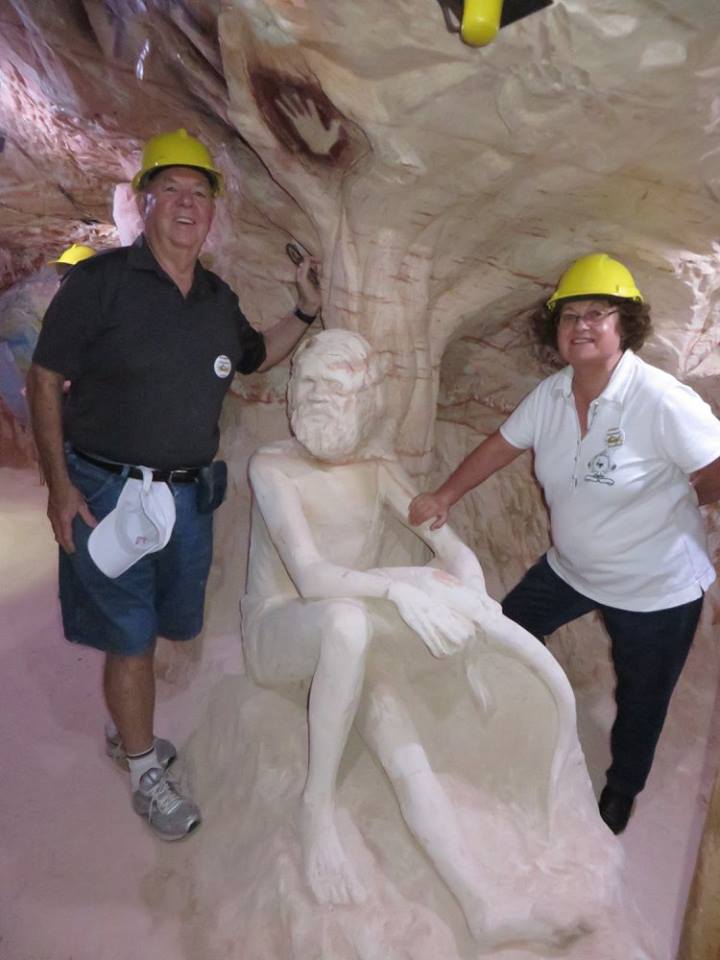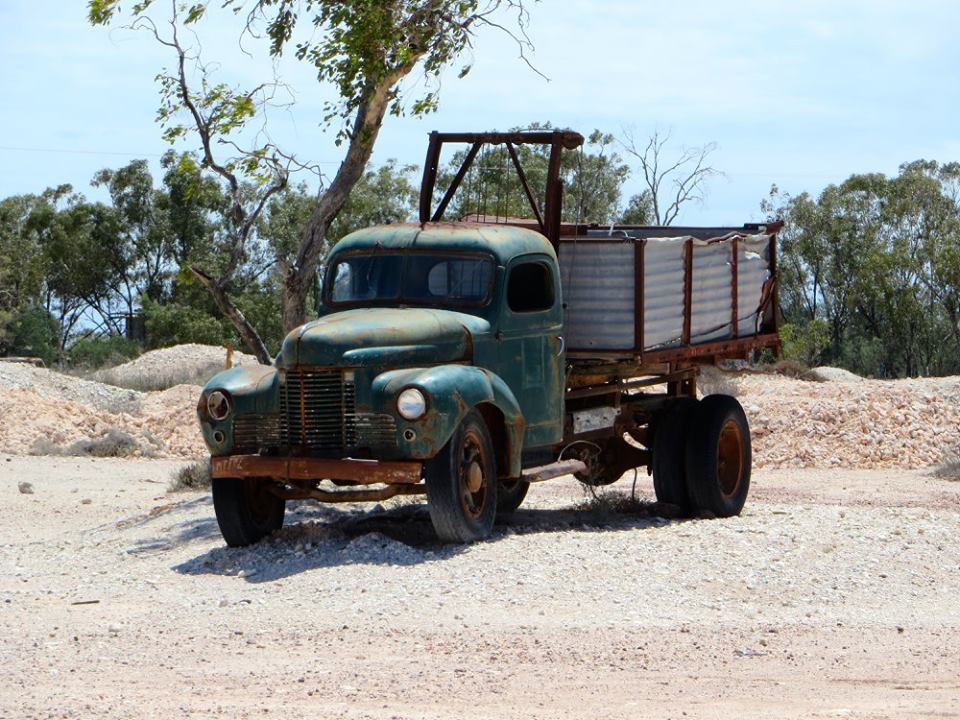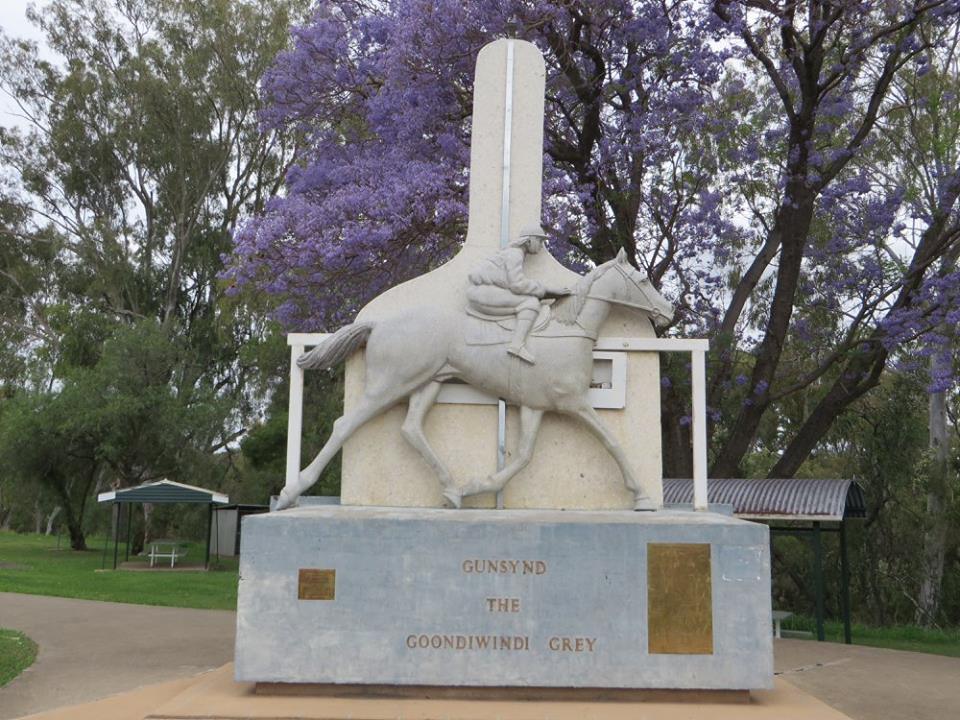Moree Coach Trip - 15 - 21 October, 2017

It was another first for us as we joined 41 Active Retirees on the Probus bus trip to Moree in North West NSW.
Probus was formed by retired Rotarians who wanted to remain active without business interests. I was elected President for this year and we felt we should join the annual bus trip planned by our club.
In our report, we've included links to the local websites. You can click the underlined links to see more of the attractions in and around Moree. There are also links to 9 albums, featuring over 150 photographs.
Click here to view our Moree photos.
Sunday, 15 October 2017
It was an early start when we were dropped us off with our bags at Rockdale Station at 6.30am. The bus was loaded with the bulk of our members, on the way to Central Railway Station where we picked up a few more passengers, then headed north across the Sydney Harbour Bridge. It was a quiet Sunday morning, so traffic was very light, even with a Cycle Ride across the bridge with hundreds of riders.
Our Coach Captain, Graham from Pegasus Coaches, explained the route and that we would stop every 2-3 hours for a comfort stop and to allow him his mandated driving rest periods. We made our first stop at Ourimbah because it was raining and we had a problem with the windscreen wipers. When they could not be fixed, it gave our front seat passenger, Allessandra, a worrying trip.
At Maitland the rain had stopped as we headed west up the Hunter Valley and stopped at Macca's Muswellbrook for lunch at noon. Then we had afternoon tea served by Graham in the park at Gunnedah and then crossed the Black soil plains past Mt Kaputar to Moree where we arrived just before 6pm at the Dragon & Phoenix Resort.
Click here to view our Dragon & Phoenix Resort photos.
We had a Chinese Buffet Banquet for dinner and all were glad to have an early night after a long day on the road.
Monday, 16 October
Today was a leisurely day in Moree. We started with a great cooked breakfast at the resort then a short drive to the local Visitor Centre, beside the Mehi River which runs through the town. I was impressed with the standard of the displays and local produce on sale at all of the centres we visited. They are were well worth a visit to any of these country towns.
We then had a quick tour by bus up the main streets of Moree where a fire in 1928 destroyed most of the old wooden buildings. The town centre was rebuilt in 1928-1929 with concrete buildings in the Art Deco Style. The buildings have ornate facades and very similar to the main street of Napier, New Zealand, which was constructed during the same period after being destroyed by a huge earthquake.
Next we stopped at the local TAFE (Technical and Further Education) college where they have set up the Mehi Gallery to teach local Aboriginal people skills in creating art in native designs. We were shown around the art studio by Davey "Crockett" Craigie, a local Kamilaroi Aboriginal who has great artwork using dot painting to depict native themes.
Click here to view our Mehi Gallery photos.
After the ladies had made their purchases in the Mehi Gallery Shop, our whole group took their places for a photo which Crockett had laminated and delivered to all on Wednesday night for a gold coin donation (Great Photo).
Back at the Resort we had a light sandwich lunch then we hit the Artesian Pools for a therapeutic afternoon. The 40 °C (104 °F) water comes from deep underground in the Great Artesian Basin. There is also an outdoor pool area and an indoor spa with 3 large 10-person spas with jets and bubbles which Elizabeth really found helped her painful leg muscles.
Tuesday, 17 October
We had an early breakfast, huge with bacon, sausages, eggs and baked beans, all difficult to resist, before setting off for a 2 1/2 hr trip to Lightning Ridge.
Click here to view our Chamber of Lightning Ridge photos.
At Collarenebri we stopped in the park by the Barwon River, where Graham served morning tea after slaving over boiling water and "baking" Arnott's biscuits overnight.
As we headed west the country was drier and we spotted many more dead kangaroos by the road so I was glad not to be driving here at night. Just outside Lightning Ridge we took photos of "Big Bird", a 15-metre-high steel sculpture of a bird constructed from 3 scrapped Volkswagen Beetles and 2 satellite dishes. It was supposed to go up at Birdsville but they did not want it so the local residents pitched in and got it built.
Our first stop was at the visitor centre. I had a fossick for opal chips in the mullock heap of old mine tailings but it had been very well picked over.
The highlight of the trip was the visit to the Chamber of the Black Hand which is a working black opal mine. The owner has only made $20,000 out of opals in 20 years so he started carving figures in the soft sandstone with a fork and spoon and now makes a fortune charging $35/person to see his sculptures. It was 70 steps down to the carving level and it was a maze of beautiful and funny carvings. The photos on Facebook are only a few of the 200 photos I took. There was a small 2-person elevator which brought Elizabeth and a few others up to the surface and the miner talked to them as they came up to take their mind off the claustrophobic space.
Click here to view our Chamber of Black Hand photos.
Unfortunately the original pub which I had visited 51 years ago had burnt down so I had to settle for a beer over our sandwich lunch at the LR Bowling Club. They were running the Black Opal Classic which is a men's triple lawn bowls competition with $25,000 in prize money.
After lunch we had a drive through the town and some of the diggings. We stopped at the John Murray Art Gallery (he did the Cockatoos bowling Echidnas in the pictures at LRBC, seen on Facebook), before heading back to Moree with another stop at Collarenebri.
We had our dinner and then headed to the artesian spa to work out the kinks from sitting 5 hours in the bus.
Wednesday, 18 October
Today we had a leisurely start as we were visiting Trawalla Pecan Plantation, which is only 35km from Moree and the name is Aboriginal for "flooded waters".
Click here to view our Trawalla Pecan photos.
There are 95,000 pecan trees planted on 700 hectares and fronts onto the Gwydir River. We had a terrific local  guide, Scott, tell us all about the development of the biggest pecan plantation in the southern hemisphere, started here in the 1960s. I did not know that the pecan is a North American tree and all varieties are named after American Indians, with 2 varieties planted here in alternate rows, namely Wichita and Western Schely.
guide, Scott, tell us all about the development of the biggest pecan plantation in the southern hemisphere, started here in the 1960s. I did not know that the pecan is a North American tree and all varieties are named after American Indians, with 2 varieties planted here in alternate rows, namely Wichita and Western Schely.
The trees are irrigated from the river and were just regrowing their leaves and flowering. The nuts form by February and the leaves turn in April. All the nuts are harvested by shaking the tree in May and sweeping up the nuts. They are sent to Toowoomba in Queensland for processing and packing for export to China and the world.
It was interesting to see the screening plant and the tall towers with circular saws that prune all the trees to 15m high and cut the sides of the tree on alternate years to allow sunlight into the nuts.
We had lunch at the Dragon & Phoenix and a swim in the outdoor pool which is about 30 °C before Graham dropped into the Visitor Centre for a tasting of Gwydir Grove olives and flavoured olive oils. The mandarin flavour is apparently used as a dressing over fruit salad and there was even a truffle flavour.
Elizabeth went on with the other ladies to hit Millers for ladies' dresses. After the tasting I joined her and took some photos of the Art Deco buildings.
We had time for a spa before dinner and after a couple of glasses of red wine we toddled off to bed.
Thursday, 19 October
Today we headed east across the plains and into the foothills of the Greta Dividing Range, which runs down the east coast of Australia.
Our morning tea stop was at the Cranky Rock Reserve, just out of Warialda. There is a legend that a "cranky Chinaman" murdered a woman in 1874 after she told him not to play poker with her son. The locals chased him but he managed to escape to the bush where he is supposed to have jumped off the cliffs to avoid capture by the locals. It is a pretty area with huge granite boulders, with a track up to a lookout where the leap is said to have occurred.
Click here to view our Cranky Rock Reserve photos.
Then it was on to Inverell, a prosperous town on the Macintyre River with a big abattoir. It is also famous for sapphire mining and cutting.
Click here to view our Inverell photos.
We arrived at the Pioneer Park at 11.30am and had a quick look around at the old buildings, collected from around the New England area and wonderfully displayed with historic artefacts.
Lunch was a sausage sizzle served by local volunteers who were very hospitable and proud of their local history.
We spent another couple of hours wandering through old buildings and equipment. I particularly enjoyed the Mining Museum with the history of tin mining in the area as one of my first jobs as a metallurgist was analysing tin ore from the mines in the area. I checked and tin is now US$25,000/tonne so I am sure there are some who wish there was still a smelter here in Australia.
Mid-afternoon, we picked up the manager of the local tourist information centre. He gave us a guided 30-minute trip around the town, pointing out the historic buildings, before we had a look at the visitor centre and the Billabong Blue sapphire shop.
Back at the Dragon & Phoenix, it was into the spa and then a second Chinese buffet dinner.
Friday, 20 October
It was an easy start today as it was only 1 1/2 hours to head north from Moree to Goondiwindi on the Queensland border. We stopped here for morning tea at the Natural Heritage and Water Park, which is set up for inland water skiing on the Macintyre River.
Our female guide, Fay, joined us as we drove back across the border into New South Wales to the Goondiwindi Cotton Company's huge farm named Alcharinga, where she explained how genetically modified cotton is grown. The fields are laser levelled to a fall of 1 inch in 15 feet (she must have been an oldie like me, so no metric) and a head channel provides water to the black siphon pipes. This flows down the rows of cotton to the tail channel, where all water is returned to the main dam by lifters. There are no water drains off the property.
In front of a 2-row harvester seen in the photos, she explained the growing of the genetically modified cotton from Monsanto seeds. After 2 rotations of cotton crop, the fields are then sown with wheat or chickpeas to return nitrogen to the soil. Now they have 6 row harvesters, costing $1.25 million. The cotton goes to local 'gins' (engines), which remove the seeds and bales to cotton bolls in 500-pound bales for export mainly to China. Currently about A$500/bale and there is a property in the area for sale at A$100 million.
To move to a vertically integrated business, Goondiwindi Cotton Co. started making clothing from cloth woven from Australian cotton. They started with the Local TAFE, teaching designing and sewing to local ladies. From there, the business has grown so large with sales to 420 stores. The clothing is now manufactured in China but the design and despatch is still done here and our ladies really enjoyed their shopping in the Goondiwindi Cotton Store.
Outside the store was a cotton plant which is a variety of hibiscus. It had just come into flower so we were lucky to see it as they only last 7 days before the flower dies and the cotton boll starts to form.
Lunch was a sandwich in a pub in the main street and while Elizabeth had a look for another stroll through town, I checked out the Victoria Hotel. Built in 1898, it looks like a black & white wedding cake. It has a Gunsynd Lounge where all the records of the famous racehorse are displayed and well worth a look.
As we left town, we stopped by the river park on the Macintyre River to take a photo of Gunsynd's statue, in honour of the horse called The Goondiwindi Grey.
Click here to view our Goondiwindi photos.
Back at the D&P, it was into the spa yet again before we had a lovely dinner with photos all round. George, our host, donated 4 bottles of wine so Muriel ran a trivia content. We managed to find a winner on each table so it was a great finale to a happy stay at the Dragon & Phoenix.
Saturday, 21 October
It was up early with bags in the coach before a 6.30am breakfast. I had my last full breakfast for a while I am sure.
We took off at 7am and it was a reverse of our run up. At a stop for morning tea at Gunnedah, there was a small local market which kept us entertained during Graham's break. Then on to stop at Macca's for lunch in Muswellbrook and a comfort stop at Ourimbah, before crossing the Harbour Bridge in light Saturday afternoon traffic. After dropping a few passengers at Central Station, we were at Rockdale just before 5.30pm.
It was the first time we have done such a trip in many years. We got to know more of the members of our Probus group much better and look forward to next year's trip to inland Australia.
John & Elizabeth Paterson

 ®
®